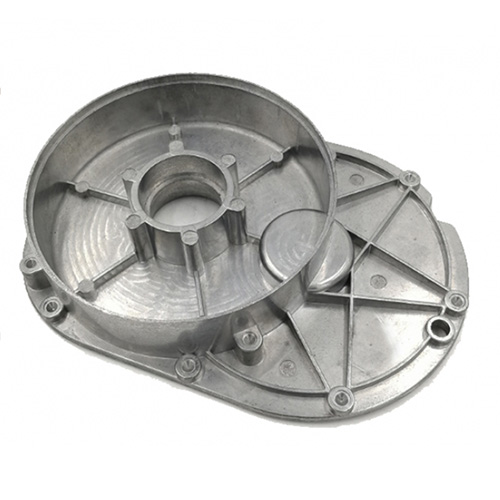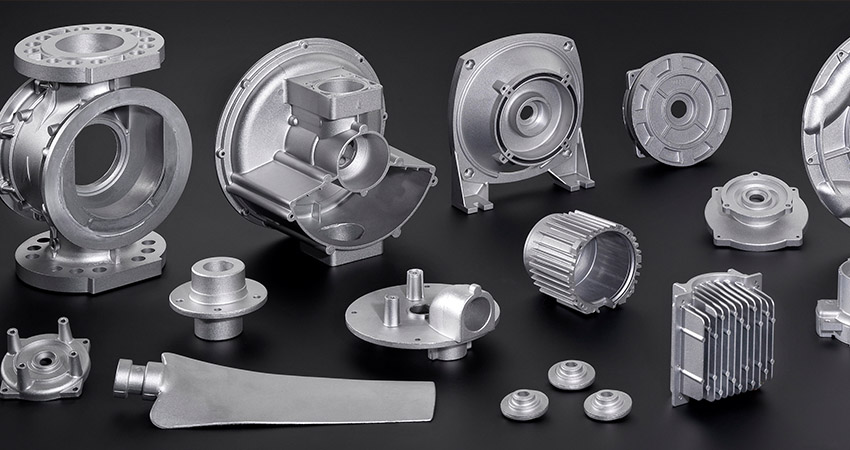The detailed checklist for Aluminum Casting projects
Wiki Article
Understanding the Advantages and Selections of Aluminum Castings in Industry
Aluminum castings have actually become significantly essential across numerous markets due to their special residential or commercial properties and manufacturing flexibility. Their lightweight and corrosion-resistant nature makes them ideal for demanding applications. Various casting methods enable precise and detailed layouts. As markets progress, recognizing the series of light weight aluminum casting choices and their benefits is crucial. This exploration questions regarding their future role in production and sustainability. What exists in advance for aluminum in these fields?The Basics of Aluminum Casting Processes
Aluminum spreading processes vary in method, they all share an usual goal: to change molten aluminum into accurate forms and parts. The main methods of aluminum spreading include sand spreading, pass away spreading, and investment spreading. In sand casting, molds are developed using sand, allowing for intricate layouts yet typically resulting in a harsh surface area finish. Die casting employs high-pressure injection of liquified aluminum into metal molds, yielding high accuracy and smooth surfaces, ideal for automation. Financial investment spreading, or lost-wax casting, involves creating a wax pattern coated with a ceramic shell, giving extraordinary detail and dimensional accuracy. Each technique has its specific applications and factors to consider, consisting of cost, production volume, and complexity of the forms produced. Recognizing these basic techniques is vital for markets that count on aluminum castings to meet their style and practical needs.Key Advantages of Using Aluminum Castings
Aluminum castings supply various advantages that make them a preferred choice in numerous industries. Among the essential advantages is their light-weight nature, which enables for much easier handling and decreased shipping costs. This characteristic contributes to boosted power effectiveness, particularly in vehicle and aerospace applications. Additionally, aluminum shows excellent rust resistance, expanding the life expectancy of components and lessening upkeep requirements.One more benefit is the convenience of aluminum castings, which can be formed into complex shapes, enabling innovative designs that typical products might not fit. The thermal and electrical conductivity of aluminum additionally makes it perfect for applications requiring warmth dissipation or effective electric connections. Aluminum castings are recyclable, lining up with sustainability objectives and reducing environmental influence. Generally, the mix of stamina, resilience, and adaptability makes light weight aluminum castings a vital element in contemporary manufacturing methods throughout numerous industries.
Common Sorts Of Aluminum Castings
Aluminum castings are produced with various techniques, each suited for various applications and demands. Among the most common strategies are sand spreading, which supplies versatility and cost-effectiveness, and pass away spreading, recognized for its accuracy and performance. Understanding these processes is vital for picking the suitable casting technique for specific commercial requirements.Sand Casting Process
A significant section of light weight aluminum castings in sector is generated through the sand spreading process, which is renowned for its adaptability and cost-effectiveness. This technique includes creating a mold from a sand combination, allowing for the manufacturing of complex shapes and large parts. Sand casting is specifically advantageous for little to medium-sized manufacturing runs, as it needs minimal preliminary financial investment in tooling. The procedure begins with pattern making, complied with by mold prep work, pouring molten light weight aluminum, and ultimately, cooling down and completing. The high thermal conductivity of aluminum guarantees also cooling, reducing the threat of issues. Consequently, sand casting remains a favored selection for producers seeking effectiveness and flexibility in their aluminum spreading applications.Die Casting Techniques
Die casting techniques represent a very efficient technique for generating aluminum castings, especially fit for high-volume production. These techniques primarily consist of two typical types: hot chamber and chilly chamber die casting. In hot chamber die spreading, the liquified aluminum is infused right into the mold and mildew from a tank that is heated, making it perfect for low-melting-point alloys. On the other hand, chilly chamber die casting entails putting the molten light weight aluminum right into a separate chamber prior to injection, which accommodates greater melting-point products. Both techniques supply precision fit intricate geometries and accomplishing superb surface area coatings. Furthermore, die spreading is understood for its rapid cycle times, reducing production prices while preserving consistency in top quality across huge amounts of parts.Applications in the Automotive Industry
Changing car layout and efficiency, light weight aluminum castings play an essential role in the vehicle industry. These castings add considerably to weight reduction, improving fuel effectiveness and total lorry characteristics. Trick applications consist of engine blocks, transmission housings, and suspension components, where their light-weight visit our website nature and toughness are crucial.Aluminum castings likewise enable for intricate geometries, enabling makers to develop elaborate designs that enhance airflow and minimize drag. This ability is specifically beneficial in electrical and hybrid cars, where performance and performance are critical.
Furthermore, the rust resistance of light weight aluminum prolongs the life-span of auto parts, minimizing maintenance prices and improving automobile reliability. The flexibility of aluminum castings sustains both mass production and personalized applications, making them a preferred option amongst automotive designers and designers. Aluminum Casting. As the market remains to introduce, aluminum castings will continue to be a critical element in the pursuit of innovative auto technologies
Aerospace Sector Application
In the aerospace sector, aluminum castings are indispensable to the design and capability of aircraft parts. These castings are used in numerous applications, including engine components, architectural components, and interior installations. Their lightweight nature adds to enhanced fuel efficiency and total performance, which is necessary in aerospace engineering.Aluminum castings likewise use exceptional strength-to-weight ratios, allowing makers to develop detailed layouts without endangering architectural integrity. The ability to generate complex geometries makes light weight aluminum casting a favored option for components that require precision and integrity.
Additionally, aluminum's resistance to deterioration enhances the durability of aerospace parts, minimizing upkeep prices and enhancing safety and security (Aluminum Casting). The spreading process permits high-volume manufacturing, satisfying the sector's needs for performance. In general, light weight aluminum castings play an essential duty beforehand aerospace innovation and optimizing aircraft style, adding to the industry's continuous advancements

Benefits Over Other Materials
Aluminum castings offer significant benefits over various other products, making them a favored selection in numerous sectors. Among the main benefits is their light-weight nature, which adds to reduced energy usage and boosted efficiency in applications such as auto and aerospace. Furthermore, aluminum exhibits outstanding corrosion resistance, enabling prolonged durability and minimized upkeep prices.The material's superior thermal and electrical conductivity additionally boosts its charm, specifically in applications calling for warmth dissipation or effective power transfer. Aluminum Casting. Aluminum castings additionally offer exceptional dimensional stability, making read the article sure precise resistances and lowering the possibility of defects during the manufacturing process
The adaptability of light weight aluminum permits for intricate shapes and intricate styles, which can be accomplished with numerous casting approaches. This adaptability makes light weight aluminum a valuable alternative for producers intending to innovate while maintaining cost-effectiveness and high quality. In conclusion, aluminum castings stick out as a result of their unique mix of buildings that deal with varied commercial needs.
Future Trends in Aluminum Casting Innovation
Future fads in light weight aluminum spreading technology are significantly concentrated on automation and the advancement of sophisticated alloys. Automation stands to boost performance and precision in casting processes, minimizing labor prices and improving product uniformity. Simultaneously, improvements in alloy formulations assure to broaden the variety of applications for light weight aluminum castings, resolving details performance demands in various industries.Automation in Casting Processes

Advanced Alloys Growth
With the ongoing development of product science, the growth of advanced alloys is readied to transform light weight aluminum spreading technology noticeably. These ingenious alloys are made to improve mechanical residential or commercial properties, deterioration resistance, and thermal security, satisfying varied industrial applications. Scientists are concentrating on hybrid alloys that integrate components such as magnesium, silicon, and zinc to achieve peak efficiency. In addition, developments in computational modeling and simulation are making it possible for the prediction of alloy actions under numerous conditions, streamlining the design procedure. The assimilation of reusing modern technologies is likewise ending up being necessary, enabling makers to produce high-performance light weight aluminum castings while minimizing ecological influence. As these patterns continue, the light weight aluminum casting sector is most likely to witness significant renovations in efficiency, sustainability, and product quality.Frequently Asked Questions
How Is Aluminum Casting Environmentally Friendly?
The inquiry of aluminum spreading's ecological kindness develops from its recyclability and lower energy intake compared to other metals. Additionally, developments in sustainable methods additionally enhance its environmentally friendly credibility within making processes.What Is the Normal Life Expectancy of Aluminum Castings?
The common life expectancy of light weight aluminum castings differs based on application and setting, usually varying from several years to years. Elements such as exposure to destructive aspects and mechanical stress and anxiety can significantly affect their resilience and longevity.Can Aluminum Castings Be Recycled?
Aluminum castings can undoubtedly be reused. This process considerably reduces waste and saves resources, enabling producers to recycle materials effectively. Recycling aluminum castings adds to sustainability and lessens the environmental influence related to aluminum manufacturing.What Are the Common Flaws in Aluminum Castings?
Usual issues in light weight aluminum castings consist of porosity, shrinking, imbalance, and surface area blemishes. These problems can arise from inadequate putting methods, inappropriate alloy make-up, or not enough cooling, eventually impacting the high quality and efficiency of the final product.Just how Do I Select the Right Aluminum Casting Refine?
Choosing the appropriate aluminum spreading process needs evaluating manufacturing quantity, part intricacy, and wanted homes. Elements such as cost, preparation, and material characteristics additionally influence the decision, making sure perfect results for particular applications.Report this wiki page